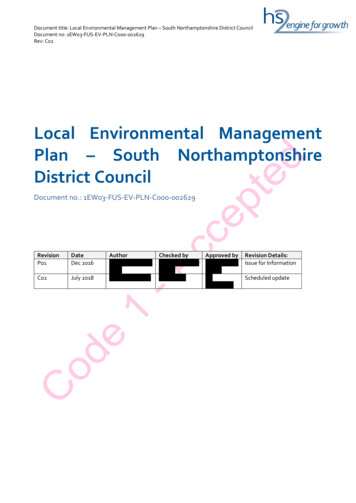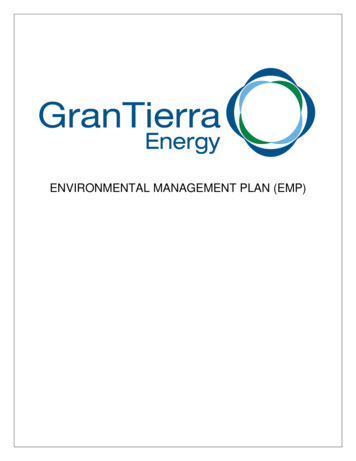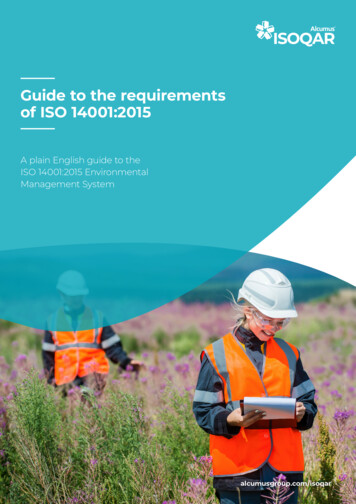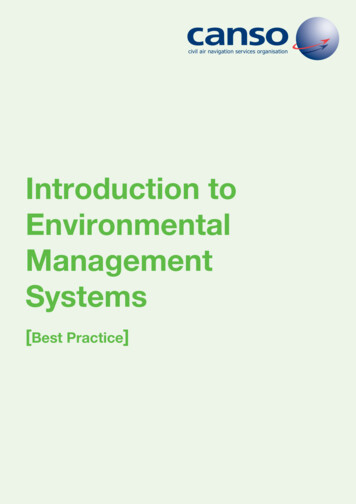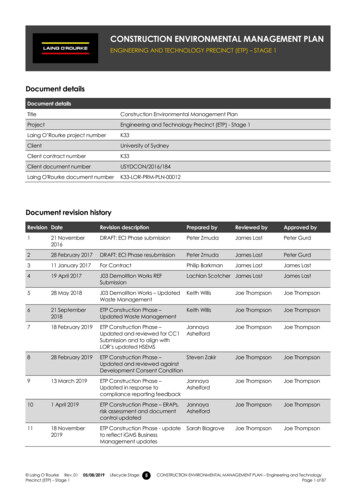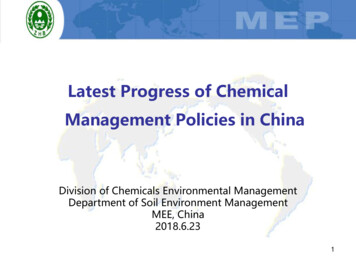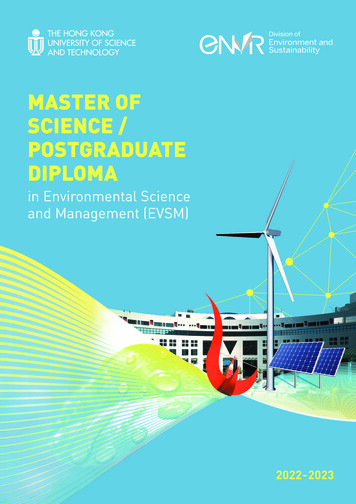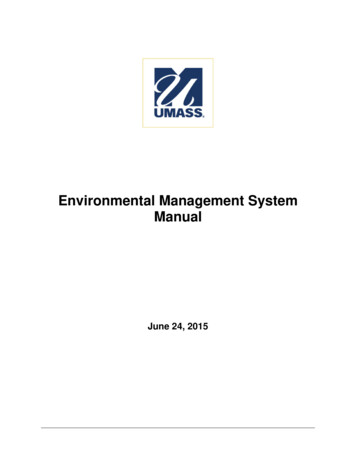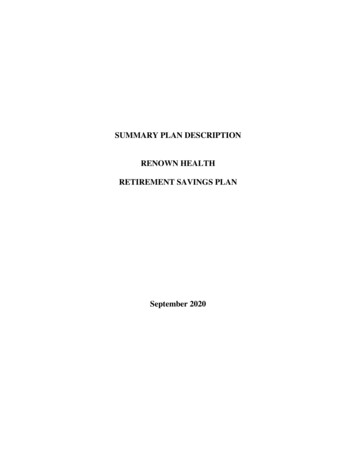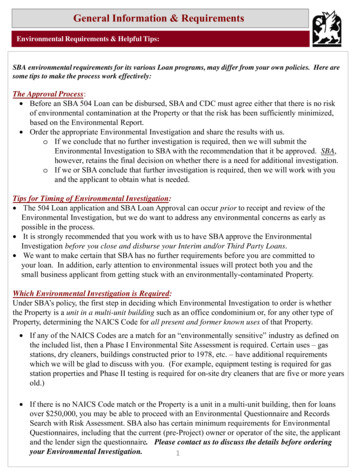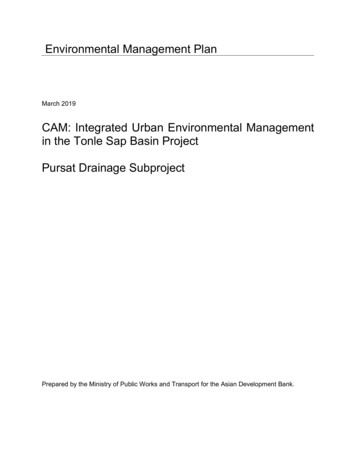
Transcription
Environmental Management PlanMarch 2019CAM: Integrated Urban Environmental Managementin the Tonle Sap Basin ProjectPursat Drainage SubprojectPrepared by the Ministry of Public Works and Transport for the Asian Development Bank.
This environmental management plan is a document of the borrower. The views expressed hereindo not necessarily represent those of ADB's Board of Directors, Management, or staff, and maybe preliminary in nature. Your attention is directed to the “terms of use” section on ADB’s website.In preparing any country program or strategy, financing any project, or by making any designationof or reference to a particular territory or geographic area in this document, the AsianDevelopment Bank does not intend to make any judgments as to the legal or other status of anyterritory or area.
KINGDOM OF CAMBODIAMINISTRY OF PUBLIC WORKS AND TRANSPORTIntegrated Urban Environmental Management inthe Tonle Sap Basin (IUEMTSB)ADB Loan 3311-CAM (SF)/ 8295-CAM (SCF), Grant No. 0454-CAMBIDDING DOCUMENTSforThe ProcurementofConstruction of Pursat DrainageSUPPLEMENTARY INFORMATIONPART A ENVIRONEMNTAL MANAGEMENT PLAN (EMP), UNEXPLODED ORDNANCE CLEARANCE (UXO), GENDER ACTION PLAN (GAP)Executing Agency:MINISTRY OF PUBLIC WORKS AND TRANSPORTProject Title:Integrated Urban Environmental Management inthe Tonle Sap Basin ProjectLoan/Grand No.:ADB Loan 3311-CAM (SF)/ 8295-CAM (SCF), Grant No. 0454-CAMICB No.:PMU/MPWT/IUEMTSBP/ICB/CW05March 2019
ENVIRONEMNTAL MANAGEMENT PLAN (EMP)
CURRENCY EQUIVALENTS(as of 5 December 2018)Currency unitKR 1.00 1.00– Riel (KR) 0.000248KR –––––––––––––––Asian Development BankAffected PeopleBiochemical Oxygen DemandConstruction Environmental Management PlanContractor Environmental Health and Safety OfficerChemical Oxygen DemandExecuting AgencyEnvironmental Impact AssessmentEnvironmental Management PlanEnvironmental Safeguard OfficeGrievance Redress MechanismGrievance Redress CommitteeInitial Environmental ExaminationInter-ministerial Resettlement CommitteesHealth and SafetyMinistry of EnvironmentMinistry of Public Works and TransportProvincial Department of EnvironmentProject Implementation ConsultantsPIC-International and National Environment SpecialistsProject Implementation UnitPIU Environmental Safeguards CounterpartProject Management and Implementation SupportPMU Environmental Safeguards OfficerProject Management UnitProvincial Department of Public Work and TransportProject Steering CommitteeProvincial Department of EnvironmentPersonal Protective EquipmentSafeguards Policy StatementSend MessageTotal Suspended SolidWorld Health OrganisationWastewater Treatment Plant
WEIGHTS AND MEASURESdBAkmkm2LAeq––––moCPM10PM 2.5–A-weighted DecibelKilometerSquare kilometerEquivalent Continuous Level ‘A weighting’ - ‘A’-weighting correction byfactors that weight sound to correlate with the sensitivity of the humanear to sounds at different frequenciesMeter–––Degree CelsiusParticulate Matter 10 micrometers or lessParticulate Matter 2.5 micrometers or lessNOTE(i)In this report, " " refers to US dollars.This environmental management plan is a document of the borrower. The views expressedherein do not necessarily represent those of ADB's Board of Directors, Management, orstaff, and may be preliminary in nature. Your attention is directed to the “terms of use”section on ADB’s website.In preparing any country program or strategy, financing any project, or by making anydesignation of or reference to a particular territory or geographic area in this document, theAsian Development Bank does not intend to make any judgments as to the legal or otherstatus of any territory or area.
TABLE OF CONTENTSI. INTRODUCTION . 11.11.2INTRODUCTION . 1SUMMARY OF POTENTIAL RECEPTORS & IMPACTS . 2II. INSTITUTIONAL ARRANGEMENTS & RESPONSIBILTIES. 6III. MITIGATION MEASURES . 11IV. MONITORING & REPORTING . 204.1 PROJECT READINESS MONITORING FOR URBAN DRAINAGE AND WWTP PURSAT . 204.2 ENVIRONMENTAL QUALITY MONITORING . 214.3 ENVIRONMENTAL QUALITY MONITORING . 224.4 EMP COMPLIANCE MONITORING . 234.5 ENVIRONMENTAL POLICY AND STANDARDS . 24V. PUBLIC CONSULTATION AND PARTICIPATION . 25VI. GRIEVANCE REDRESS MECHANISM . 266.1 OBJECTIVE . 266.2 APPROACH . 266.3 ACCESS TO THE MECHANISM. 276.4 COMMUNICATION ON THE GRM: PROJECT HOTLINE . 276.5 RECORDING PROJECT HOTLINE OR GRM ISSUES: STEPS AND TIMELINE . 286.6 MANAGING UNRESOLVED COMPLAINTS. 31VII. REPORTING. 33VIII. CONCLUSIONS . 34
LIST OF FIGUREFIGURE 1: DRAINAGE LINE IN PURSAT TOWN . 4FIGURE 2: WWPT LAYOUT . 5LIST OF TABLETABLE 1: LIST OF ALIGNMENTS FOR CONSTRUCTION . 1TABLE 2: RECEPTOR SUMMARY . 2TABLE 3: KEY FUNCTIONS FOR PROJECT IMPLEMENTATION . 6TABLE 4 RESPONSIBILITIES FOR ENVIRONMENTAL SAFEGUARDS . 7TABLE 5: CAPACITY BUILDING AND TRAINING REQUIREMENT . 10TABLE 6: EMP MITIGATION MEASURES . 11TABLE 6: MONITORING TYPE AND COST . 20TABLE 8: PROJECT READINESS ASSESSMENT INDICATORS . 20TABLE 9: ENVIRONMENTAL QUALITY MONITORING . 22TABLE 10: EMP COMPLIANCE AND AFFECTED PEOPLE MONITORING . 23TABLE 11: GRM ROLES AND RESPONSIBILITIES . 26TABLE 12: PROJECT HOTLINE INFORMAL CONTACT WITH AFFECTED PEOPLE . 29TABLE 13: PROJECT HOTLINE FORMAL CONTACT WITH AFFECTED PEOPLE . 29TABLE 14. REPORTING REQUIREMENTS . 33APPENDICESAPPENDIX 1: AFFECTED PERSON MONITORING FORM CONSULTATION / INTERVIEW FORM . 35APPENDIX 2: COMPLAINT RECORDING FORM . 37APPENDIX 3: PARTICULAR CONDITIONS (FOR BIDDING DOCUMENTS) . 38
1I. INTRODUCTION1.1 INTRODUCTION1.1.1 Purpose1.This document is the environmental management plan (EMP) for the Urban Drainage andWasteWater Treatment Plant subproject in Pursat city, Pursat Province subproject for theIntegrated Urban Environmental Management in The Tonle Sap Basin Project (PMIS). TheEMP for the subprojects defines mitigation and monitoring measures and describes theinstitutions, responsibilities and mechanisms to monitor and ensure compliance. Suchinstitutions and mechanisms will seek to ensure continuous improvement of environmentalprotection activities during preconstruction, construction, and operation of the subprojects inorder to prevent, reduce, or mitigate adverse impacts.2.This EMP is prepared for construction of Urban Drainage and Wastewater Treatment Plant.The other subprojects under PMIS will have individual EMPs. The integrated InitialEnvironmental Examination (IEE)* that covers all the subprojects is a separate document.*Note: IEE updated in July 2020.1.1.2 Budget3.The costs for EMP implementation comprise: Training and Capacity Building: 8,653 (See Table 5) Environmental Quality Monitoring: Pre-Construction 4,000 (Included in domestic IEIA), DuringConstruction per year 14,300 (see Table 9) (included in Bill of Quantities).4. Other aspects of the EMP including mitigation measures, reporting, affected people consultationand EMP monitoring are included in other budgets depending on the organization responsible forthe aspect e.g. PMU operational budget or included in contractor’s bid price.1.1.3 Outline of technical approach1.3.1 Urban Drainage outline Pipe-drain Drainage manholes 5.The drainage construction will include the investments shown in Table 1. Table 1: List of alignments for constructionNoD LineLength (m)1Line12Line23Line 34Line 45Line 56Line 6 7Line 7Source:DEDteam Diameter .3.2 The WWTP sub-project will comprise:2
WWTP Works: Primary Treatment: This tank has 6.4 m deep with 20.25 m long and 12.7 m wide. Anaerobic tank: This tank (total 4 tanks) has 4.2 m deep with 29.3 m long and 21.75m wide. Anaerobic filter: This filter tank has 3.3 m deep with 40 m long and 21.25 m wide. Horizontal Reed Bed (4 concrete tanks): This tank has 0.85 m deep with 40 mlong and 20 m wide. Chlorination Chamber: This tank has 2.8 m deep with 13.6 m long and 5.4 m wide. Ancillary works including: Shelter for Equipment Office Building Guard house Operations house Sludge drying bed Growth tree around WWTP 1.2 SUMMARY OF POTENTIAL RECEPTORS & IMPACTS6.The impacts of the project are influenced by the presence of receptors in the sub-project area;without receptors, there will not be any impacts. The receptors are summarised in Table 2.7.In addition to these site specific receptors, housing, businesses and access requirements arealso considered impact receptors.Table 2: Receptor SummaryReceptorsDescriptionGPS Co-Ordinate or STAIrrigation Canals12 33'9.31"N, 103 54'36.33"ESurface WaterReceptorsSocio-EconomicDensely populated residential &commercial areasPower supplies - cables andelectricity poles in residentialareas and commercial areasPursat MarketAllAll12 32'19.20"N, 103 55'7.59"ECulturalPeal Nhek Pagoda12 32'24.55"N, 103 55'6.19"EHospitalSampov Meas Hospital12 32'42.55"N, 103 55'12.16"ESchoolPursat Secondary School12 32'22.01"N, 103 54'37.67"ECentreOrphanage Support Centre12 32'51.08"N, 103 54'32.87"EReceptors8.A summary of impacts on the receptors is presented below: Air Quality. Low temporary air quality impacts during the construction stage of the projectare anticipated becauseof fugitive dust generation associated with all construction works, and earth works.Noise. Noise impacts will be temporary and localized at all construction sites asconstruction machinery and vehicles generate noise as they operate. Other noise sourcesinclude loading and unloading of equipment and materials.
3 9.Surface Water. There is an irrigation canal and Pursat River in the project site. Short termconstruction impacts may be seen in terms of increasing turbidity of any water flowing acrossthe site. Effluent discharge into irrigation canal may impact on water quality if effluent standardsare not met.Solid waste management. Impacts on resource use and impacts associated with disposalwill arise from waste generated during construction. This includes generation of inertwastes e.g. spoil, biodegradable wastes e.g. cleared vegetation, and hazardous wastese.g. oily wastes. During operation, waste from the WWTP will include dried sludge andchemicals packaging.Community and Occupational Health and Safety. Construction sites and access roadswill necessarily mean health and safety risks not only to construction workers, but also topeople living and working around the WWTP and alignments. Community risks come fromunauthorized access to construction sites and construction traffic i.e. heavy vehicles whichthe community may not be used to on their neighborhood roads and changes in roadpriorities for traffic movements. Occupational risks come from a range of activities includingthe use of heavy machinery, earth moving, and use of chemicals during construction andoperation of the WWTP.The layout of the drainage is shown in Figure 1. The layout of the WWTP is shown in Figure2.
Source: DED teamFigure 1: Drainage line in Pursat town4
Source: DED teamFigure 2: WWPT layout5
6II. INSTITUTIONAL ARRANGEMENTS & RESPONSIBILTIES10.The key institutions, organizations and stakeholders relevant to environmental safeguards areset out below.11.The overall responsibility for EMP implementation and compliance with loan assurances lieswith the Executing Agency, the Ministry of Public Works and Transport. The EA hasestablished a Project Management Unit (PMU) based in Phnom Penh, responsible for generalproject implementation. The Implementing Agency is the Provincial Department of PublicWorks and Transport (PDPWT) in subproject city. The PDPWT has established a ProjectImplementation Unit (PIU) in each province, comprising relevant provincial governmentrepresentatives including the Provincial Department of the Environment.12. A summary of the key functions for project implementation and environmental safeguards ispresented in Table 3 and detail on the responsibilities of each function is in Table 4:Table 3: Key Functions for Project ImplementationRoleAbbreviationLocationPSCPhnom PenhPMUPhnom Penhwithin MPWTPMU EnvironmentSafeguards OfficerPMU-ESOPhnom Penhwithin PMUProjectImplementation UnitPIUProvinces withinPDPWTResponsible for subproject implementationPIU EnvironmentalSafeguardCounterpartPIU-ESCProvinces withinPIUNominated person responsible for subprojectenvironmental monitoring and support to PMU-ESOContractorEnvironmental, Healthand Safety OfficerC-EHSOConstruction SiteMitigation measure implementation and reportingProject Managementand ImplementationSupport ConsultantsPMISPhnom PenhProject final design and implementation, supportand capacity developmentEngineering supervision for all construction andreportingPMIS -I/NESPhnom Penhwithin PMIS teamEnvironmental safeguards and reporting supportduring design and implementation - IntermittentADB-Review project progress, compliance withcovenants and advise on corrective actionsProject SteeringCommitteeProject ManagementUnitInternational andNational EnvironmentSpecialistsAsian DevelopmentBankSummary of Overall FunctionPolicy and technical guidance for subprojectimplementationResponsible for general project implementation andreportingExisting MPWT staff seconded/assigned to the PMUfor the environmental management of the ProjectEMP compliance across the subprojects forenvironmental safeguards – Full Time
PMIS-N/IESPIU-ESCPMU / PMU-ESODPWTPSCExecuting AgencyInstitutionParticipate in training provided by PMISProvide technical advice/assistance, IEE/EMP update Review bidding documents, review C-EMP against the EMP;confirm subproject readiness.Conduct affected people consultationEstablish health & safety baseline conditions in affectedvillages.Establish GRM for Environmental Issues Coordinate and collaborate relevant provincial agencies, asnecessarySupport PMU-ESOEstablish GRM and making affected persons aware of GRMfocal points, contacts and procedures’Conduct affected people consultationParticipate in training provided by PMISEnsure MoE approval of IEIA Report has been secured prior toawarding of civil works.Review contractor’s Construction EMP (C-EMP) against ADBand IEIA requirementsEnsure EMP is part of the bidding documents, EMP clausesare incorporated in bidding documents, contracts.Update IEE & EMPCoordinate with Design Consultant to ensure the incorporationof updated findings & mitigation measures in design & biddingdocuments. Implement the GRM for environmental issues Spot checks to verify EMP implementation Provide technicaladvice/assistance, e.g,preparation of Semi-Annual EMRfor ADB,review of resultsof environmental effectsParticipate in training provided by PMIS Conduct appropriate consultation and monitoringof effect of construction on affected people Collate monthly EMRs of Contractor, and submitto the PMU.Oversee the conduct of the environmentaleffects monitoring to be managed by thecontractor and tested to be conducted by MoELaboratory.Prepare the draft Semi-Annual EMR and submitParticipate in training provided by PMISConduct appropriate consultation and monitoringof effect of construction on affected peopleReview environmental quality monitoring results.Prepare the Project’s Semi-Annual EMRs forsubmission to ADB with support from PMIS.Implement the GRM for environmental issuesConduct inspections and spot checks to monitorthe performance of the Contractor inimplementing the C-EMP/EMPReview Monthly Environmental MonitoringReports (EMRs) of Contractor Collaborate with PDoE & relevant provincial agencies on matters concerning the environmental management of the Subproject.Ensure coordinated and efficient Project implementation activities including EMP implementation Organize, prior to project completion report(PCR) mission, a survey to assess communitysatisfaction with project implementation andEMP implementation performance.DraftSupport reporting requirements of PMU.Ensure all GRM complaints are closed out toaffect person’s satisfactionReview relevant operator monitoring reportsPrepare the Project’s Annual EMR forsubmission to ADB, until loan closure or asagreed.Ensure all GRM complaints are closed out toaffect person’s satisfactionReview relevant operator monitoring reports.Oversee implementation in conformity with the Project’s development objectives and scope Assist in coordination among government agencies involved in Project implementation including MoECollaborate with the MoE for the Subproject’s compliance with the Government’s environmental safeguard requirements on IEIA and EMP implementation Ministry of Public Works and Transport responsible for ensuring the implementation of the mitigation in the EMP and for ensuring compliance with loan covenantsDuring Operation and Decommissioning During Construction Prior to Construction including Detailed Engineering DesignTable 4 Responsibilities for Environmental Safeguards7
torADB addressesasminimumtheFacilitate & participate in GRM dissemination and implementationFacilitate obtaining the necessary inputs from and/orparticipation/cooperation of,concerned communes andvillages through collaboration with their Commune Councils.Facilitate (& participate in) GRM dissemination andimplementationReview, comment on approve IEIA ReportPrepare a C-EMP thatrequirements of the EMP.Review bidding documents, clear C-EMP, confirm readiness ofsubproject.Review and clear updated IEE/EMP Support PMU/PIU with appropriate consultation in bidding documents, contractsIncorporate EMP as part of bidding documents, EMP clauses Environmental related training for PMU, PIU, contractors andother stakeholdersIncorporate mitigation measuresin design & biddingdocumentsDesignEnsure environmental considerations included in Detailed Facilitate & participate in GRM disseminationand implementation.Review EMRs & results of environmental effectsmonitoring.Participate in the monitoring of the performanceof Contractor in EMP implementation.Facilitate & participate in GRM disseminationand implementation.Review EMRs & results of environmental effectsmonitoringParticipate in the monitoring of the performanceof Contractor in EMP implementation.Monitor compliance with approved IEIA & EMP.Prepare Monthly EMRs.Conduct environmental quality monitoring asprescribed in SPS-compliant EMP. (If anindependent Licensed Laboratory will not beengaged.)Implement mitigation measures & conductinternal EMP implementation monitoring. .Carry out review missionsReview Project EMRs. Site visits to check on construction,EMPimplementation and affected people, incollaboration with PMUSupport PMU/PIU with appropriate consultation monitoring.Environmental related training for PMU, PIU,contractors and other stakeholders Monitorcompliancewithenvironmentalstandards. Implement mitigation measures & conductinternal EMP implementation monitoring.Prepare Monthly and Annual EMRs. environment sections of the PCR.8
91.1. Institutional Capacity Review and Needs13.Currently there is little experience of monitoring and implementing environmental mitigationmeasures particularly at a provincial level. There is little enforcement of environmental orhealth and safety legislation and routine environmental monitoring is not undertaken apartfrom in major urban centers (air quality) or irrigation canal & major river (water quality).14.During the update of this EMP the team checked the capacity and experience at MPWT andfound that there are a number of people who have fulfilled the role of ‘focal point’ forsafeguards on project by project basis. The project will co-ordinate with this existingenvironmental safeguard office (ESO) in MPWT and will include ESO staff in training andreviews.15.In addition, through understanding existing operations for drainage system and Waste WaterTreatment Plan in Pursat, it is clear that there is limited ability for operation and maintenance.The limiting factors affecting the operators’ ability to maintain adequate standards are likely tobe a function of (i) a lack of technical capacity and experience; (ii) lack of staff and (iii)insufficient budget.16. A training program is set out Table 5 which addresses the safeguard reporting andimplementation requirements during construction, and the environmental and social risks fromoperations.17.The PMIS -I/NES will perform key roles in supporting the PMU-ESO in implementing the EMPand ensuring the pre-construction requirements are in place.
PMU, PIU,contractors,Included as part of the annual budget from waste water unit under provincial department of transportation. Thescope of the training is currently under discussion with MPWT and will include Operation and Maintenance ofWWTP and an exposure visit to an operational site in Sihanoukville and Siem Reap provinceEnvironmental monitoring Monitoring methods, data collectionand processing, reporting systemsUrban Drainage and WWTPPMIS -I/NES& MoE (environmentalanalyst)PMIS -I/NESPMU, PIU,contractorsEnvironmental protectionPollution control on construction sites(air, noise, wastewater, solid waste)Once (at beginning ofproject construction)Once (during projectimplementation)221PMIS -I/NESTwice Once before, andonce 6 months afterconstruction starts1,2468,653Total1,2462,829101024841PMU, PIU,contractors,CommuneCouncils6Grievance Redress Mechanism –roles, responsibilities andimplementation0.5Once before toconstruction2,491USDparticipants10Cost ( )# ofPMIS -I/NES2Days / eventTwice Once before, andonce 6 months afterconstruction startsWhen/FrequencyPMU, PIUTrainer/OrganizationPMIS -I/NESParticipantsPMU, PIU,contractorsEMP development andimplementationEMP functionRoles and responsibilities,EMP monitoring (Site Visits)Reporting on EnvironmentalSafeguardsConsultation with Affected PeopleConsulting during construction, typesof consultation, methodsSubject / ContentTable 5: Capacity building and training requirement10
1 Costs3. Establish GRM and clarify roles and responsibilities (see GRMsection of EMP)4. Provide contractor with GRM contact details to be used for:A. GRM sign boardsB. GRM Contact Cards for Affected People5. Erect sign boards at the construction site entrance with:A. Project detailsB. GRM procedures and contact details6. Print 'GRM Contact Cards' for all workers to give to complainantsand keep cards with all vehicles, machinery and sitemanagers/foremen7. Affected People Training. Contractor to raise awareness of allworkers on how to respond when an affected person or member ofthe public has a complaint i.e. direct the person to the most seniorsite manager present at the time and provide a 'GRM ContactCard'will need to be updated during detailed design phaseGRM Dissemination-2. Initiate Information Disclosure and Grievance process of IEE atPursat townNo communityimpactsIncluded in BidPriceIncluded inProject costInclude inproject costresettlementplans1. No Affected householdsenvironmentalimpactsrelocations, &compensationDisclosure, &engagementof communitySeeNo negativePRE-CONSTRUCTIONConfirmation ofrequired lementPMUPMUPMUEA/IAResponsibilityEstimated Cost1Implementation Supervision( oposed Mitigation MeasuresConstruction Environmental Management Plans. The Contractor is expected to develop a specific Construction Environmental ManagementPlan (C-EMP) for the subproject, which sets out the contractor’s approach to implementing required mitigation measure.Mitigation measures for environmental impacts are shown in Table 6Table 6.Table 6: EMP Mitigation Measures19.18.III. MITIGATION MEASURES11
Earthworks andexcavationsBiddingConstruction EMP(CEMP) ApprovalsAir Quality,Soilresources,trafficNoise andAllComplianceobligationsAllConstruction EMP(C-EMP)Obtain & activatepermits andlicensesAllPotentialEnvironmentalImpactsIEE and EMPUpdatedSubprojectActivityIncluded in BidpriceIncluded inProject costmaterial handling areaswhen fugitive dustis noticeablygenerated.16. All topsoil and overburden removed should be stockpiled for laterrestoration15. Water will be sprayed at least twice per day on construction sites,CONSTRUCTION PHASEParticular Conditions for Bidding Documents.Included in ctor(C-EHS)PMISLocal licensedCompany imated Cost1Implementation Supervision( )11. Contractors to comply with all statutory requirements set out byGovernment for use of construction equipment, and operationInclude in bidconstruction plants.price12. Contractor to ensure all required permits including materialsextraction permits are in place prior to construction.13. Approval of C-EMP including site maps as required by CEMPInclude inbefore construction is allowed to start.Project cost14. Incorporate EMP into the bid and contract requirements, includinga). Access routes, b). storage areas for waste, c). storage areafor chemicals such as fuels, d) concrete mixing, e) stockpilestorage areas (on & off site), f) first aid kit and equipment used inemergency response, g) location of worker camps (if required).10. The CEMP will include a map of each construction site, withcopies held by the Contractor and PIU, showing as a minimum:A. final detailed designB. further necessary environmental protection measuresC. approved national IEIA requirements & mitigation measures.D. environmental quality baseline monitoring (water, air, noise)IEIA approved by MoE prior to contract award9. The contractor(s) will develop a Construction EMP (C-EMP) thatincludes the mitigation measures set out in this table as aminimum and will include detailed individual management subplans for:A. Solid and Liquid Waste Management;B. Community and Occupational Health and Safety andEmergency Response;C. Construction Workers and Camp Management (if required)and.8. Update IEE and EMP to include:Proposed Mitigation Measures12
Use of Machinery &EquipmentMaterialsConstructionTransport, storageand Use ofCivil WorksActivitySubprojectNoise,WaterAir pollution,CommunityHealth&Safety,TrafficLoss ordisruption ofutilities andservices,economic suchas water supplyand electricityEnvironmentalImpactsPotentialprice( )500m downwind from the nearest dwellings in order to reducethe impact of fumes on humans and to be fitted with necessaryequipment such as bag house filters to reduce fugitive dustemissions.30. Water will be sprayed on material storage areas, and borrow pitswhere fugitive dust is generated and where vehicles aretransporting materials on unmade roads, generating dust, wherehuman receptors are within 300m.31. Maintain all exhaust systems in good working order; undertakeregular equipment maintenance;29. Asphalt and concrete batching facilities will be located at leastIncluded in BidPrice17. The contractor will provide a Traffic Management Plan to thePMU for approval which will include:a) How the contractor will inform the community and businesses ofconstruction traffic routesb) Any advice/information the contractor will give to affectedpeople during constructionc) How the contractor will manage traffic including any roadclosures specifying management around Pursat Market.18. Trained traffic marshal will be used to direct vehicle movements onand around construction sites and in all urban areas.19.
This document is the environmental management plan (EMP) for the Urban Drainage and WasteWater Treatment Plant subproject in Pursat city, Pursat Province subproject for the Integrated Urban Environmental Management in The Tonle Sap Basin Project (PMIS). The EMP for the subprojects defines mitigation and monitoring measures and describes the
